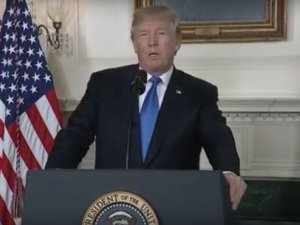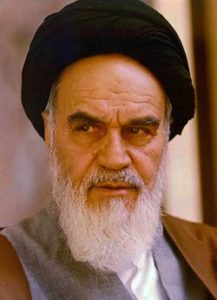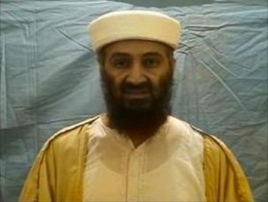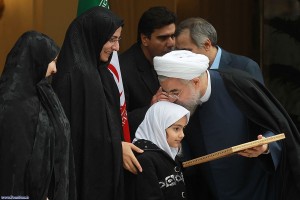A group of U.S. intelligence veterans urges President Trump to stop his administration’s false claims about Iran being the leading state sponsor of terrorism when U.S. allies, such as Saudi Arabia, are clearly much guiltier.
[Reposted with permission of the Editor Consortium News]
—————
MEMORANDUM FOR: The President
FROM: Veteran Intelligence Professionals for Sanity
SUBJECT: Is Iran the “World’s Leading Sponsor of Terrorism?”
EXECUTIVE SUMMARY/BACKGROUND
We are concerned by recent strident and stark public statements from key members of your Administration that paint Iran in very alarmist terms. The average American, without the benefit of history, could easily be persuaded that Iran poses an imminent threat and that there is no alternative for us but military conflict.
President Donald Trump addresses the nation about his Iran policy on Oct. 13, 2017. (Screenshot from Whitehouse.gov)
We find this uncomfortably familiar territory. Ten years ago former President George W. Bush was contemplating a war with Iran when, in November of 2007, intelligence analysts issued a formal National Intelligence Estimate (NIE) debunking the prevailing conventional wisdom; namely, that Iran was on the verge of getting a nuclear weapon. The NIE concluded that Iran had stopped working on a nuclear weapon in 2003.
Recalling this moment in his memoir, Decision Points, President Bush noted that the NIE’s “eye-popping” intelligence findings stayed his hand. He added this rhetorical question: “How could I possibly explain using the military to destroy the nuclear facilities of a country the intelligence community said had no active nuclear weapons program?”
We believe that you are facing a similar situation today. But instead of an inaccurate claim that Iran has nuclear weapons, the new canard to justify war with Iran is the claim that Iran remains the “world’s leading state sponsor of terrorism.” This is incorrect, as we explain below.
* * *
One of the recurring big bipartisan lies being pushed on the public with the enthusiastic help of a largely pliant media is that Iran is the prime sponsor of terrorism in the world today.
In the recent presentation of your administration’s National Security Strategy for 2018, the point is made that:
“Iran, the world’s leading state sponsor of terrorism, has taken advantage of instability to expand its influence through partners and proxies, weapon proliferation, and funding. . . . Iran continues to perpetuate the cycle of violence in the region, causing grievous harm to civilian populations.”
Those sentiments are echoed by several other countries of the Middle East. Saudi Arabia’s Foreign Minister, Adel al-Jubeir, for example, declared in October 2015 that: Iran “is the biggest sponsor of terrorism in the world, and it is working on destabilizing the region.”
The Saudi foreign minister conveniently declined to mention that 15 of the 19 terrorists who hijacked planes and attacked America on 11 September 2001 were Saudis, not Iranians. And, while Iran was an active promoter of terrorism two decades ago, it is no longer in the forefront of global terrorism. Ironically, that dubious distinction now goes to Iran’s accusers — first and foremost, Saudi Arabia.
The depiction of Iran as “the world’s leading state sponsor of terrorism” is not supported by the facts. While Iran is guilty of having used terrorism as a national policy tool, the Iran of 2017 is not the Iran of 1981. In the early days of the Islamic Republic, Iranian operatives routinely carried out car bombings, kidnappings and assassinations of dissidents and of American citizens. That has not been the case for many years. Despite frequent claims by U.S. officials that Iran is engaged in terrorism, we simply note that the incidents recorded annually in the U.S. Department of State’s Patterns of Global Terrorism rarely identifies a terrorist incident as an act by or on behalf of Iran.
Iran’s relationship with Hezbollah also has evolved radically. In the early years of the Islamic Republic, Hezbollah was often a proxy and sub-contractor for Iran. But during the last 20 years Hezbollah has become an entity and political force in its own right. It fought Israel to a standstill in 2006 in southern Lebanon, which was a watershed moment in establishing Hezbollah’s transformation into a conventional army. In the intervening years, Hezbollah, which is now part of the Lebanese government, also has turned away from the radical, religious driven violence that is the hallmark of the Sunni extremists, like ISIS.
Iran’s Asymmetrical Response
After Iran fell under the rule of the Ayatollah in 1979 terrorism, its role in high profile terrorist attacks, such as the taking of U.S. hostages and the bombings of the U.S. Embassy and the Marine barracks in Lebanon, fed understandable U.S. animosity towards Iran. But Iran’s actions were not driven primarily by blind hatred or radical religious views. For Iran terrorism was a way to punch back against more powerful foes, principally the United States, which was providing military and intelligence support to Iran’s neighbor and enemy, Iraq.
Portrait of the late Ruhollah Khomeini by Mohammad Sayyid
The Iranians were also pragmatic and had direct dealings with Israel. During the early days of the Iranian revolution the Mullahs, despite publicly denouncing Israel, happily accepted secret military support from the Israelis. Israel was equally pragmatic. The Israeli leaders ignored the Mullahs and gave the support as a means of helping counter the threat posed by Iraqi President Saddam Hussein. A classic case of the enemy of my enemy is my friend.
The public image of Iran as a hotbed of fanatical terrorists has been usurped since the August 1998 bombings of the U.S. Embassies in east Africa by Al Qaeda and other radical Sunni entities. The U.S. Government’s own list of terrorist attacks since 2001 shows a dramatic drop in the violence carried out by Iran and an accompanying surge in horrific acts by radical Sunni Muslims who are not aligned with Iran. The latest edition of the Global Terrorism Index, a project of the U.S. Department of Homeland Security, shows that four groups accounted for 74 percent of all fatalities from terrorism in 2015 — Boko Haram, Al-Qaeda, the Taliban and ISIS.
Thirteen of the 14 Muslim Groups identified by the U.S. intelligence community as actively hostile to the US are Sunni, not Shia, and are not supported by Iran:
– ISIS (Sunni)
– The Al-Nusra Front (Sunni)
– Al-Qa’ida Central (Sunni)
– Al-Qa’ida in Magheb (Sunni)
– Al-Qa’ida in Arabian Peninsula (Sunni)
– Boku Haram (Sunni)
– Al-Shabbab (Sunni)
– Khorassan Group (Sunni)
– Society of the Muslim Brothers (Sunni)
– Sayyaf Group in the Philippines (Sunni)
– Taliban in Pakistan and Afghanistan (Sunni)
– Lashgar i Taiba (Sunni)
– Jemaa Islamiya (Sunni)
– Houthis (Shia)
The last major terrorist attack causing casualties that is linked to Iran was the July 2012 bombing of a bus with Israeli tourists in Bulgaria. That departure from Iran’s more recent policy on terrorism was retaliation for what Iran perceived to be Israel’s role in assassinating five Iranian scientists involved with Iran’s Nuclear program, between January 2010 and January 2012 (the dates and names of those attacked are appended).
One can easily imagine the outrage and lust for revenge that would sweep the U.S., if Americans believed a foreign country sent operatives into the United States who in turn murdered engineers and scientists working on sensitive U.S. defense projects.
Special Operations
There have been other terrorist attacks inside Iran bearing the handprint of support from the United States. Author Sean Naylor, Relentless Strike, which details the history of operations carried out by U.S. Joint Special Operations Command (JSOC) over the past 30 years, sheds light on this uncomfortable truth:
The late Al-Qaeda leader Osama bin Laden.
“JSOC personnel also worked with the Mujahideen-e-Khalq (MEK), a militant Iranian exile group that had based itself in Iraq after falling afoul of the ayatollahs’ regime in Tehran. The State Department had placed the MEK on its list of designated terrorist organizations, but that didn’t stop JSOC from taking an attitude of “the enemy of my enemy is my friend” toward the group. “They were a group of folks that could transit the border, and they were willing to help us out on what we wanted to do with Iran,” said a special operations officer.”
The MEK were classified as a terrorist group, until the United States decided that as long as the MEK would help kill Iranians rather than Americans, that they were no longer terrorists. The MEK’s history of terrorism is quite clear. Among more than a dozen examples over the last four decades these four are illustrative:
- During the 1970s, the MEK killed U.S. military personnel and U.S. civilians working on defense projects in Tehran and supported the takeover in 1979 of the U.S. Embassy in Tehran.
- In 1981, the MEK detonated bombs in the head office of the Islamic Republic Party and the Premier’s office, killing some 70 high-ranking Iranian officials, including Iran’s President, Premier, and Chief Justice.
- In April 1992, the MEK conducted near-simultaneous attacks on Iranian embassies and installations in 13 countries, demonstrating the group’s ability to mount large-scale operations overseas.
- In April 1999, the MEK targeted key military officers and assassinated the deputy chief of the Iranian Armed Forces General Staff.
Despite this history, a bipartisan parade of prominent U.S. political and military leaders has lobbied on behalf of MEK and has been well compensated in return.
Benighted Policy So Far
In the ultimate ironic turn, the U.S.-led 2003 war in Iraq played a critical role in Iran’s resurgence as a regional power. Saddam Hussein was replaced by Shia muslims who had received sanctuary in Iran for many years and Baathist institutions, including the Army, were taken over by Iraqis sympathetic to Tehran.
Iran has come out ahead in Iraq and, with the 2015 nuclear agreement in place, Iran’s commercial and other ties have improved with key NATO allies and the other major world players—Russia and China in particular.
Official pronouncements on critical national security matters need to be based on facts. Hyperbole in describing Iran’s terrorist activities can be counterproductive. For this reason, we call attention to Ambassador Nikki Haley’s recent statement that it is hard to find a “terrorist group in the Middle East that does not have Iran’s fingerprints all over it.” The truth is quite different. The majority of terrorist groups in the region are neither creatures nor puppets of Iran. ISIS, Al-Qaeda and Al-Nusra are three of the more prominent that come to mind.
You have presented yourself as someone willing to speak hard truths in the face of establishment pressure and not to accept the status quo. You spoke out during the campaign against the 2003 U.S. invasion of Iraq as a historic mistake of epic proportions. You also correctly captured the mood of many Americans fatigued from constant war in far away lands. Yet the torrent of warnings from Washington about the dangers supposedly posed by Iran and the need to confront them are being widely perceived as steps toward reversing your pledge not to get embroiled in new wars.
We encourage you to reflect on the warning we raised with President George W. Bush almost 15 years ago, at a similar historic juncture:
“after watching Secretary Powell today, we are convinced that you would be well served if you widened the discussion … beyond the circle of those advisers clearly bent on a war for which we see no compelling reason and from which we believe the unintended consequences are likely to be catastrophic.”
Iran’s President Hassan Rouhani celebrates the completion of an interim deal on Iran’s nuclear program on Nov. 24, 2013, by kissing the head of the daughter of an assassinated Iranian nuclear engineer. (Iranian government photo)
________________________
APPENDIX
LIST OF IRANIAN SCIENTISTS ASSASSINATED IN IRAN
- January 12, 2010: Masoud Alimohammadi, Iranian Physicist:
- Killed by a car bomb. The perpetrator reportedly confessed to having been recruited by Israeli intelligence to carry out the assassination.
- November 29, 2010: Majid Shahriari, Iranian nuclear scientist:
- Killed by a car bomb. According to German media, Israel was the sponsor.
- November 29, 2010: Assassination attempt on Fereydoon Abbasi Iranian nuclear scientist:
- Wounded by a car bomb.
- July 23, 2011: Darioush Rezaeinejad, Iranian electrical engineer, unclear scientist
- Killed by unknown gunmen on motorcycle. Specialist on high-voltage switches — a key component of nuclear warheads. Assassinated by Israeli intelligence, according to the German press.
- January 11, 2012: Mostafa Ahmadi-Roshan, Iranian nuclear scientist
- Killed at Natanz uranium enrichment facility by a magnetic bomb of the same kind used in earlier assassinations of Iranian scientists.
________________________
Signed:
Richard Beske, CIA, Operations Officer (ret.)
William Binney, former NSA Technical Director for World Geopolitical & Military Analysis; Co-founder of NSA’s Signals Intelligence Automation Research Center
Marshall Carter-Tripp, Foreign Service Officer (ret.) and Division Director, State Department Bureau of Intelligence and Research
Bogdan Dzakovic, Former Team Leader of Federal Air Marshals and Red Team, FAA Security, (ret.) (associate VIPS)
Philip Giraldi, CIA, Operations Officer (ret.)
Larry C. Johnson, former CIA and State Department Counter Terrorism officer
Michael S. Kearns, Captain, USAF (Ret.); ex-Master SERE Instructor for Strategic Reconnaissance Operations (NSA/DIA) and Special Mission Units (JSOC)
John Kiriakou, Former CIA Counterterrorism Officer and former senior investigator, Senate Foreign Relations Committee
Karen Kwiatkowski, former Lt. Col., US Air Force (ret.), at Office of Secretary of Defense watching the manufacture of lies on Iraq, 2001-2003
Edward Loomis, NSA, Cryptologic Computer Scientist (ret.)
David MacMichael, National Intelligence Council (ret.)
Ray McGovern, former US Army infantry/intelligence officer & CIA analyst (ret.)
Elizabeth Murray, Deputy National Intelligence Officer for Near East, CIA and National Intelligence Council (ret.)
Torin Nelson, former Intelligence Officer/Interrogator (GG-12) HQ, Department of the Army
Todd E. Pierce, MAJ, US Army Judge Advocate (ret.)
Coleen Rowley, FBI Special Agent and former Minneapolis Division Legal Counsel (ret.)
Greg Thielmann — Former director of the Strategic, Proliferation, and Military Affairs Office of the State Department’s intelligence bureau (INR) and former senior staffer on the Senate Intelligence Committee
Kirk Wiebe — former Senior Analyst, SIGINT Automation Research Center, NSA
Lawrence Wilkerson, Colonel (USA, ret.), Distinguished Visiting Professor, College of William and Mary (associate VIPS)
Sarah G. Wilton, CDR, USNR, (Retired)/DIA, (Retired)
Robert Wing — former Foreign Service Officer (associate VIPS)
Ann Wright, Col., US Army (ret.); Foreign Service Officer (who resigned in opposition to the war on Iraq)










